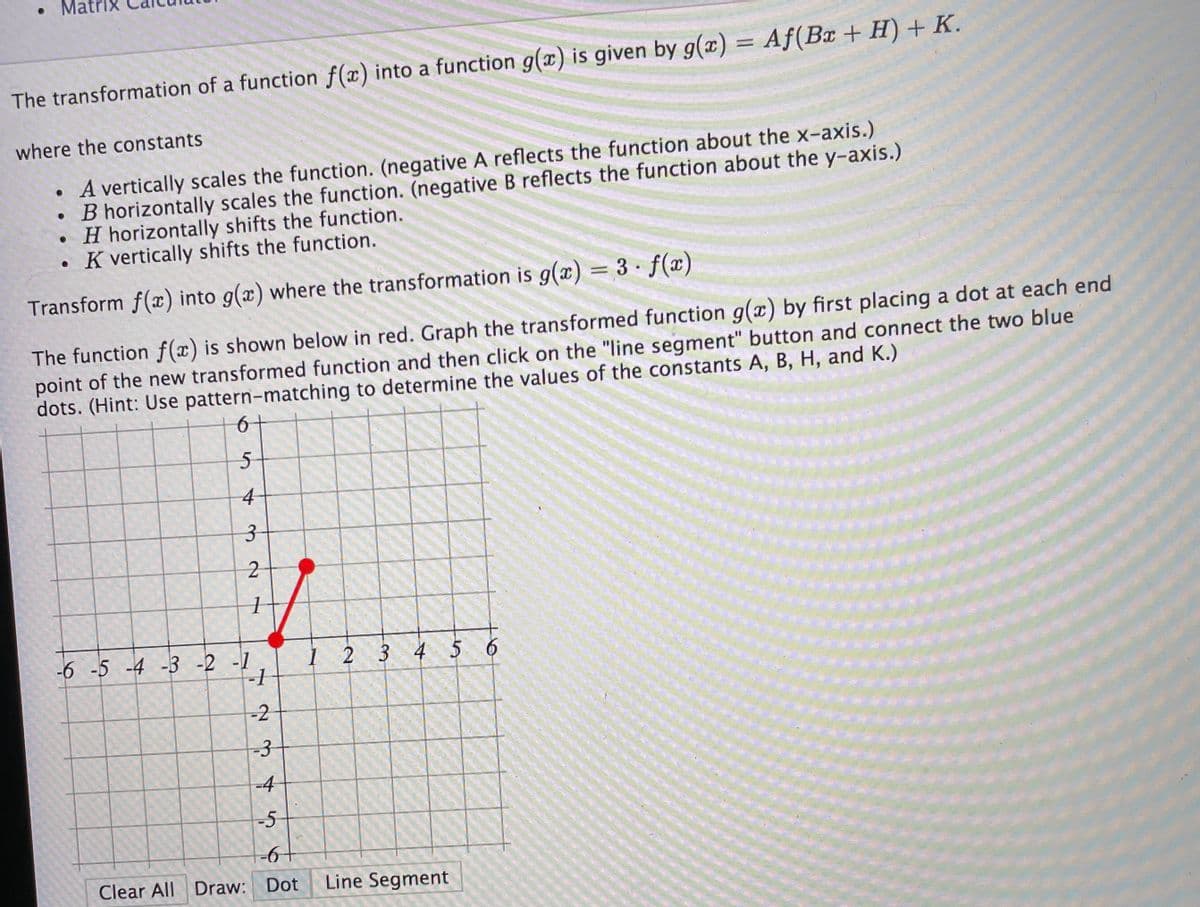The transformation of a function f(x) into a function g(x) is given by g(x) Af(Br + H) + K. where the constants • A vertically scales the function. (negative A reflects the function about the x-axis.) B horizontally scales the function. (negative B reflects the function about the y-axis.) H horizontally shifts the function. K vertically shifts the function. Transform f(x) into g(x) where the transformation is g(x) = 3 · f(x) The function f(x) is shown below in red. Graph the transformed function g(x) by first placing a dot at each end point of the new transformed function and then click on the "line segment" button and connect the two blue dots. (Hint: Use pattern-matching to determine the values of the constants A, B, H, and K.)
The transformation of a function f(x) into a function g(x) is given by g(x) Af(Br + H) + K. where the constants • A vertically scales the function. (negative A reflects the function about the x-axis.) B horizontally scales the function. (negative B reflects the function about the y-axis.) H horizontally shifts the function. K vertically shifts the function. Transform f(x) into g(x) where the transformation is g(x) = 3 · f(x) The function f(x) is shown below in red. Graph the transformed function g(x) by first placing a dot at each end point of the new transformed function and then click on the "line segment" button and connect the two blue dots. (Hint: Use pattern-matching to determine the values of the constants A, B, H, and K.)
Functions and Change: A Modeling Approach to College Algebra (MindTap Course List)
6th Edition
ISBN:9781337111348
Author:Bruce Crauder, Benny Evans, Alan Noell
Publisher:Bruce Crauder, Benny Evans, Alan Noell
Chapter3: Straight Lines And Linear Functions
Section3.3: Modeling Data With Linear Functions
Problem 17E: Later High School Graduates This is a continuation of Exercise 16. The following table shows the...
Related questions
Question

Transcribed Image Text:Ма
The transformation of a function f(x) into a function g(x) is given by g(x) = Af(Bx + H) + K.
where the constants
• A vertically scales the function. (negative A reflects the function about the x-axis.)
• B horizontally scales the function. (negative B reflects the function about the y-axis.)
• H horizontally shifts the function.
• K vertically shifts the function.
Transform f(x) into g(x) where the transformation is g(x) = 3 f(x)
The function f(x) is shown below in red. Graph the transformed function g(x) by first placing a dot at each end
point of the new transformed function and then click on the "line segment" button and connect the two blue
dots. (Hint: Use pattern-matching to determine the values of the constants A, B, H, and K.)
4
-6 -5 -4 -3 -2 -1
-1
3 4 5 6
-2
-3
-4
-5
-6+
Clear All Draw: Dot
Line Segment
3.
Expert Solution
This question has been solved!
Explore an expertly crafted, step-by-step solution for a thorough understanding of key concepts.
This is a popular solution!
Trending now
This is a popular solution!
Step by step
Solved in 2 steps with 1 images

Knowledge Booster
Learn more about
Need a deep-dive on the concept behind this application? Look no further. Learn more about this topic, algebra and related others by exploring similar questions and additional content below.Recommended textbooks for you

Functions and Change: A Modeling Approach to Coll…
Algebra
ISBN:
9781337111348
Author:
Bruce Crauder, Benny Evans, Alan Noell
Publisher:
Cengage Learning

Algebra & Trigonometry with Analytic Geometry
Algebra
ISBN:
9781133382119
Author:
Swokowski
Publisher:
Cengage


Functions and Change: A Modeling Approach to Coll…
Algebra
ISBN:
9781337111348
Author:
Bruce Crauder, Benny Evans, Alan Noell
Publisher:
Cengage Learning

Algebra & Trigonometry with Analytic Geometry
Algebra
ISBN:
9781133382119
Author:
Swokowski
Publisher:
Cengage
